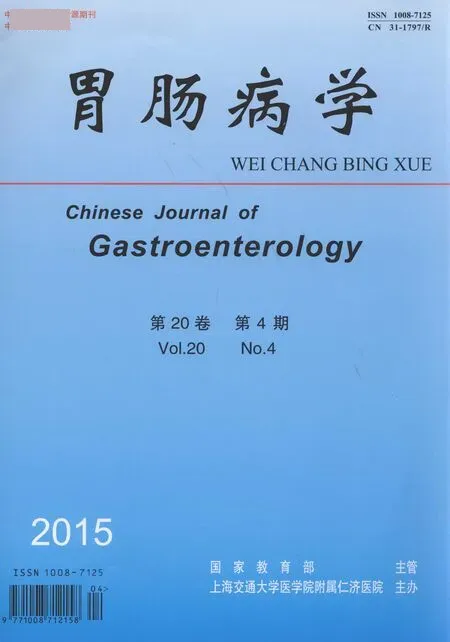神经肽S受体1基因多态性与炎症性肠病相关性的研究*
神经肽S受体1基因多态性与炎症性肠病相关性的研究*
刘适#王晓兵周峰吴婷周瑞刘静夏冰&
武汉大学中南医院消化内科(430071)

*基金项目:教育部高等学校博士学科点专项科研基金(优先发展领域)(20130141130007)
#Email: sancyliu198652@sina.com
背景:研究表明神经肽S受体1(NPSR1)基因多态性与欧洲人群炎症性肠病(IBD)的遗传易感性相关,但尚无研究探讨两者在中国人群中的相关性。目的:探讨中国汉族人群中NPSR1基因多态性与IBD的关系。方法:收集武汉大学中南医院457例确诊IBD患者[溃疡性结肠炎(UC)组355例,克罗恩病(CD)组102例]和500名健康对照者,以PCR和测序技术分析NPSR1基因rs323922(C→G突变)、rs740347(G→C突变)位点多态性。结果:UC组与对照组间、CD组与对照组间rs323922、rs740347位点的基因型频率和等位基因频率差异均无统计学意义(P>0.05)。基因型与IBD临床表型的相关性分析显示:①rs323922位点突变型CG基因型与男性CD(OR: 0.441, 95% CI: 0.230~0.844)和结肠型CD(OR: 0.425, 95% CI: 0.199~0.911)相关,为保护因素。②rs740347位点突变型CC基因型与CD早期发病(<16岁)相关(OR: 15.019, 95% CI: 2.634~86.470),突变型C等位基因与结肠型CD相关(OR: 2.142, 95% CI: 1.709~4.294),两者均为危险因素。结论:NPSR1基因rs323922、rs740347位点多态性与中国汉族人群的IBD遗传易感性无关,但与IBD的某些临床表型有关。
关键词炎症性肠病;神经肽S受体1;多态性,单核苷酸;疾病遗传易感性;中国
炎症性肠病(inflammatory bowel disease, IBD)是一组病因尚不十分清楚的慢性非特异性肠道炎症性疾病,包括溃疡性结肠炎(ulcerative colitis, UC)和克罗恩病(Crohn’s disease, CD),目前观点认为遗传易感性为IBD致病因素之一[1-2]。21世纪初,Laitinen等[3-4]通过对芬兰一个奠基者种群行全基因组扫描,发现染色体7p14-p15区域存在与哮喘和高血清IgE相关的易感位点,鉴定显示该基因编码一孤儿G蛋白耦联受体[哮喘易感性G蛋白耦联受体(GPRA)],即神经肽S受体1(neuropeptide S receptor 1, NPSR1)。之后国内外多项遗传学研究显示NPSR1基因多态性与免疫相关疾病,如支气管哮喘、类风湿关节炎等的遗传易感性有关[4-10],对意大利、瑞典、芬兰等欧洲人群的研究表明NPSR1基因多态性与IBD遗传易感性亦有关联[11-12],但尚无研究探讨两者在中国人群中的相关性。本研究通过分析中国汉族人群的NPSR1基因多态性分布情况,旨在明确该基因多态性与中国汉族人群IBD的关系,为阐明IBD的发病机制提供依据。
材料与方法
一、一般资料
收集2009年1月-2012年9月在武汉大学中南医院就诊的IBD患者457例,UC组355例,男189例,女166例,平均发病年龄(39.8±15.3)岁;CD组102例,男61例,女41例,平均发病年龄(30.5±13.5)岁。入组患者均经临床表现以及实验室、影像学、内镜和组织学检查综合诊断,符合“对我国炎症性肠病诊断治疗规范的共识意见(2007年,济南)”[13]中的相关诊断标准。收集同期于中南医院行健康体检并排除IBD以及其他免疫相关疾病和家族史的健康人500名作为对照组,其中男281名,女219名,平均年龄(41.9±12.9)岁。病例组和对照组所有个体均为汉族。UC组与CD组发病年龄差异显著,与流行病学调查中两者发病年龄高峰的整体趋势相一致[14]。
二、标本采集
受检者采集静脉血5 mL,EDTA抗凝,以血液基因组DNA提取试剂盒[天根生化科技(北京)有限公司]提取全基因组DNA。
三、基因多态性分析
本研究针对rs323922(C→G突变)、rs740347(G→C突变)两个单核苷酸多态性(SNP)位点进行分析。
1. PCR扩增目的片段:以Primer Premier 5.0软件 设计rs323922、rs740347位点的PCR引物。rs323922: F 5’-TCC ACC ATC TTG CCT GTG AG-3’,R 5’-CAG GAC CAA GTT GTG GTA GCT GTA TT-3’;rs740347:F 5’-ACA ATA ATG AAG ACT CAA TTT CAG C-3’,R 5’-AGC AGG CAA GAA GAG GAG T-3’。PCR反应体系:2×PCR Mix(北京东胜创新生物科技有限公司)12.5 μL,上、下游引物各1 μL,DNA模板2 μL,超纯水8.5 μL。反应条件:95 ℃预变性10 min;95 ℃变性30 s,60 ℃复性30 s,72 ℃延伸40 s,循环35次;终末72 ℃ 10 min。
2. 测序:由武汉擎科创新生物科技有限公司对PCR扩增产物进行测序,Chromas基因测序峰图查看软件分析结果,并录入Excel软件。
四、统计学分析
应用SPSS 17.0统计软件,组间基因型频率和等位基因频率的比较采用χ2检验和Fisher确切概率法,并计算OR值及其95% CI,P<0.05为差异有统计意义。
结果
一、遗传平衡
对病例组和对照组rs323922、rs740347位点行Hardy-Weinberg平衡检验,P值均大于0.05,表明各基因型频率达到遗传平衡,具有群体代表性。
二、基因型和等位基因频率
UC组与对照组间、CD组与对照组间rs323922、rs740347位点的基因型频率和等位基因频率差异均无统计学意义(表1、表2)。
三、基因型与IBD临床表型的相关性
分别对UC组、CD组rs323922、rs740347位点基因型与性别、发病年龄、病变部位、并发症(如狭窄、穿孔、肛周病变等)等临床参数的相关性进行分析,得出以下结论。其余纳入分析的临床参数与所检测位点基因型无相关性。
①在男性CD患者中,rs323922位点突变型CG基因型频率与对照组相比差异有统计 学意义,CG突变为男性CD的保护因素(表3)。
②在病变累及结肠的CD患者中,rs323922位点突变型CG基因型频率与对照组相比差异有统计学意义,CG突变为结肠型CD的保护因素(表3)。
③在早期发病(<16岁)CD患者中,rs740347位点突变型CC基因型频率与对照组相比差异有统计 学意义,CC突变为CD早期发病的危险因素(表4)。
④在病变累及结肠的CD患者中,rs740347位点突变型C等位基因频率与对照组相比差异有统计学意义,C等位基因为结肠型CD的危险因素(表4)。

表1 UC组与对照组间rs323922、rs740347位点基因型和等位基因频率比较 n(%)

表2 CD组与对照组间rs323922、rs740347位点基因型和等位基因频率比较 n(%)

表3 CD患者rs323922位点基因型与临床表型相关性分析

表4 CD患者rs740347位点基因型与临床表型相关性分析
讨论
神经肽S(neuropeptide S, NPS)是一种20氨基小肽,因氨基端残基均为丝氨酸(S)而得名,通过与其受体NPSR1结合,发挥调节睡眠和觉醒、抗焦虑、减少惊恐发作、影响摄食行为、调节免疫应答、炎症反应、变态反应和伤害性感受等作用[15-17]。NPSR1又名GPRA、血管加压素受体相关受体-1(VRR1)或GPR154,是一种七次跨膜G蛋白耦联受体,NPSR1-A和NPSR1-B为其最重要的2个亚型[11,18-19]。研究表明NPSR1广泛分布于人体呼吸系统、消化系统、上皮组织以及肝、脾、淋巴结等免疫器官,外周血单核细胞表面亦有NPSR1表达[20]。目前观点认为NPS-NPSR1信号与哮喘、类风湿关节炎、IBD等免疫相关疾病有密切联系。动物和细胞实验显示,炎症状态下,食管、胃、小肠、结肠上皮内NPSR1表达升高,提示其与胃肠道炎症反应有关[21];对IBD患者肠组织标本的检测显示NPSR1 mRNA和蛋白表达显著上调[11]。NPS-NPSR1信号可能系通过上调环磷酸腺苷(cAMP)、蛋白激酶A(PKA)表达和胞内Ca2+浓度,介导相关信号转导,参与IBD发病[19]。此外,NPS-NPSR1信号还可上调多种胃肠激素表达,如胆囊收缩素、血管活性肠肽、生长抑素等,引起相应临床症状[22-23]。
关于NPSR1基因多态性的研究显示,rs323922、rs740347位点多态性与类风湿关节炎以及过敏症状的发生相关[8,24],鉴于免疫相关疾病通常具有共同的SNP位点,意大利、瑞典、芬兰等欧洲国家已开展针对这两个位点多态性与IBD遗传易感性关系的研究[11],但迄今尚无关于NPSR1基因多态性与中国人群IBD遗传易感性关系的研究报道。本研究检测了中国汉族人群的NPSR1基因rs323922、rs740347位点多态性,尽管欧洲研究发现rs323922位点与CD显著相关[11],但本研究结果显示UC组与对照组间、CD组与对照组间两位点基因型频率和等位基因频率差异均无统计学意义,表明两者与IBD并无关联。然而,本研究同时发现rs323922位点突变型CG基因型与男性CD和结肠型CD相关,为两者的保护因素;rs740347位点突变型CC基因型与CD早期发病相关,突变型C等位基因与结肠型CD相关,两者均为危险因素。
尽管本研究对入组IBD患者的疾病活动度进行了评估,但该参数系随病情不断变化,难以按某一标准确定惟一数值,因此未能对SNP位点与疾病活动度的关系进行分析。此外,本研究样本量和时间跨度均较大,期间患者使用氨基水杨酸制剂、免疫抑制剂、生物制剂等多种方法进行治疗,治疗方案根据病情变化随时调整,因此亦未能对SNP位点与药物疗效进行相关性分析。
IBD的遗传易感性有明显的种族差异,在东西方人群之间尤为显著[2],本研究结果与针对欧洲人群研究结果间的差异再次证实了此种种族差异的存在。尽管本研究未发现NPSR1 基因rs323922、rs740347位点多态性与中国汉族人群的IBD遗传易感性之间存在相关性,但观察到部分突变与IBD的某些临床表型有关,因此尚不能排除NPSR1基因多态性与中国汉族人群IBD发病相关。后续拟进一步探索其他NPSR1基因SNP位点与IBD的关系,以明确该基因是否为中国汉族人群IBD的易感基因。
参考文献
1 Uhlig HH, Schwerd T, Koletzko S, et al; COLORS in IBD Study Group and NEOPICS. The diagnostic approach to monogenic very early onset inflammatory bowel disease[J]. Gastroenterology, 2014, 147 (5): 990-1007.e3.
2 Cho JH, Weaver CT. The genetics of inflammatory bowel disease[J]. Gastroenterology, 2007, 133 (4): 1327-1339.
3 Laitinen T, Daly MJ, Rioux JD, et al. A susceptibility locus for asthma-related traits on chromosome 7 revealed by genome-wide scan in a founder population[J]. Nat Genet, 2001, 28 (1): 87-91.
4 Laitinen T, Polvi A, Rydman P, et al. Characterization of a common susceptibility locus for asthma-related traits[J]. Science, 2004, 304 (5668): 300-304.
5 Malerba G, Lindgren CM, Xumerle L, et al. Chromosome 7p linkage and GPR154 gene association in Italian families with allergic asthma[J]. Clin Exp Allergy, 2007, 37 (1): 83-89.
6 Hersh CP, Raby BA, Soto-Quirós ME, et al. Comprehensive testing of positionally cloned asthma genes in two populations[J]. Am J Respir Crit Care Med, 2007, 176 (9): 849-857.
7 D’Amato M, Zucchelli M, Seddighzadeh M, et al. Analysis of neuropeptide S receptor gene (NPSR1) polymorphism in rheumatoid arthritis[J]. PLoS One, 2010, 5 (2): e9315.
8 Robledo G, González-Gay MA, Fernández-Gutiérrez B, et al. NPSR1 gene is associated with reduced risk of rheumatoid arthritis[J]. J Rheumatol, 2012, 39 (6): 1166-1170.
9 朱红艳,吴健民,崔天盆. 湖北汉族变应性哮喘患者GPR154基因单倍型分析[J]. 中华医学遗传学杂志, 2007, 24 (1): 48-51.
10赵明哲,杨远. 支气管哮喘及焦虑与NPSR1基因多态性的相关性研究[J]. 中华结核和呼吸杂志, 2014, 37 (5): 365-367.
11D’Amato M, Bruce S, Bresso F, et al. Neuropeptide s receptor 1 gene polymorphism is associated with susceptibility to inflammatory bowel disease[J]. Gastroenterology, 2007, 133 (3): 808-817.
12Anedda F, Zucchelli M, Schepis D, et al. Multiple poly-morphisms affect expression and function of the neuropeptide S receptor (NPSR1)[J]. PLoS One, 2011, 6 (12): e29523.
13中华医学会消化病学分会炎症性肠病协作组. 对我国炎症性肠病诊断治疗规范的共识意见(2007年,济南)[J]. 中华消化杂志, 2007, 27 (8): 545-550.
14王玉芳,欧阳钦,胡仁伟,等. 炎症性肠病流行病学研究进展[J]. 胃肠病学, 2013, 18 (1): 48-51.
15Pape HC, Jüngling K, Seidenbecher T, et al. Neuropeptide S: a transmitter system in the brain regulating fear and anxiety[J]. Neuropharmacology, 2010, 58 (1): 29-34.
16Donner J, Haapakoski R, Ezer S, et al. Assessment of the neuropeptide S system in anxiety disorders[J]. Biol Psychiatry, 2010, 68 (5): 474-483.
17Roth AL, Marzola E, Rizzi A, et al. Structure-activity studies on neuropeptide S: identification of the amino acid residues crucial for receptor activation[J]. J Biol Chem, 2006, 281 (30): 20809-20816.
18Vendelin J, Pulkkinen V, Rehn M, et al. Characterization of GPRA, a novel G protein-coupled receptor related to asthma[J]. Am J Respir Cell Mol Biol, 2005, 33 (3): 262-270.
19Pietras CO, Vendelin J, Anedda F, et al. The asthma candidate gene NPSR1 mediates isoform specific downstream signaling[J]. BMC Pulm Med, 2011, 11: 39.
20Pulkkinen V, Majuri ML, Wang G, et al. Neuropeptide S and G protein-coupled receptor 154 modulate macrophage immune responses[J]. Hum Mol Genet, 2006, 15 (10): 1667-1679.
21Sundman L, Saarialho-Kere U, Vendelin J, et al. Neuropeptide S receptor 1 expression in the intestine and skin -- putative role in peptide hormone secretion[J]. Neurogastroenterol Motil, 2010, 22 (1): 79-87, e30.
22Henström M, Zucchelli M, Söderhäll C, et al. NPSR1 polymorphisms influence recurrent abdominal pain in children: a population-based study[J]. Neurogastroenterol Motil, 2014, 26 (10): 1417-1425.
23Camilleri M, Carlson P, Zinsmeister AR, et al. Neuropeptide S receptor induces neuropeptide expression and associates with intermediate phenotypes of functional gastrointestinal disorders[J]. Gastroenterology, 2010, 138 (1): 98-107.e4.
24Bruce S, Nyberg F, Melén E, et al. The protective effect of farm animal exposure on childhood allergy is modified by NPSR1 polymorphisms[J]. J Med Genet, 2009, 46 (3): 159-167.
(2014-12-16收稿;2015-01-08修回)
Association of Neuropeptide S Receptor 1 Gene Polymorphisms with Inflammatory Bowel DiseaseLIUShi,WANGXiaobing,ZHOUFeng,WUTing,ZHOURui,LIUJing,XIABing.DepartmentofGastroenterology,ZhongnanHospitalofWuhanUniversity,Wuhan(430071)
Correspondence to: XIA Bing, Email: bingxia@aliyun.com
Background: Studies showed that neuropeptide S receptor 1 (NPSR1) gene polymorphisms were associated with the susceptibility of inflammatory bowel disease (IBD) in Europe’s populations, however, there is no study on the relevance in Chinese population. Aims: To investigate the association of NPSR1 gene polymorphisms with IBD in Chinese Han population. Methods: A total of 457 IBD patients [355 cases of ulcerative colitis (UC) and 102 cases of Crohn’s disease (CD)] from Zhongnan Hospital of Wuhan University and 500 healthy controls were recruited. Genotyping of 2 single nucleotide polymorphisms (SNPs) of NPSR1, rs323922 (C→G mutation) and rs740347 (G→C mutation) was performed by using PCR and sequencing techniques. Results: Differences of the frequencies of genotypes and alleles for rs323922 and rs740347 between UC, CD patients and controls didn’t reach statistical significance (P>0.05). Genotype-phenotype analysis showed that there were some impact of genotypes for rs323922 and rs740347 on clinical phenotypes of IBD: (i) For rs323922, mutant CG genotype was correlated with male CD patients (OR: 0.441, 95% CI: 0.230-0.844) and CD involving the colon (OR: 0.425, 95% CI: 0.199-0.911), and might be a protective factor. (ii) For rs740347, mutant CC genotype was correlated with early onset CD patients (<16 years old) (OR: 15.019, 95% CI: 2.634-86.470) and mutant C allele was correlated with CD involving the colon (OR: 2.142, 95% CI: 1.709-4.294), both were risk factors. Conclusions: Polymorphisms of NPSR1 rs323922 and rs740347 are not contributors of IBD susceptibility in Chinese Han population, but might be correlated with some clinical phenotypes of IBD.
Key wordsInflammatory Bowel Disease;Neuropeptide S Receptor 1;Polymorphism, Single Nucleotide;Genetic Predisposition to Disease;China
通信作者&本文,Email: bingxia@aliyun.com
DOI:10.3969/j.issn.1008-7125.2015.04.003

